
WARNING: Spoilers for “Remembrance,” the first episode of ‘Star Trek: Picard’ lie ahead. If you haven’t seen the episode yet and do not wish to have any information spoiled for you, the time to stop reading is now!
To say that the first episode of ‘Star Trek: Picard’ was a welcome sight for die-hard Trek fans is a massive understatement. While much of the fan base has been split on whether they like or dislike the pre-Classic Series-set ‘Star Trek: Discovery,’ the pilot episode of ‘Picard’ brought things back to the far, far future for Trek faithful – in fact, this series is now officially the furthest “in the future,” chronologically speaking, that any series has routinely gone. (I say “routinely” because, of course, random one-off episodes of the various Trek series have ventured further into the future via time travel and the like.)
The first episode, “Remembrance,” was filled to the brim with callbacks to the Trek that has come before – specifically, ‘Star Trek: The Next Generation’ and the feature films inhabited by that show’s cast (‘Generations,’ ‘First Contact,’ and ‘Nemesis’) – and even a few scenes from the JJ Abrams-led “reboot” version of Star Trek feature films from the last 11 years. While not all of these references necessarily qualify as hidden or hard-to-notice “Easter eggs” – things like an appearance by the Enterprise-D, Data singing “Blue Skies,” and seeing Picard and Data in various iterations of former Starfleet uniforms are almost expected, given the “Anguished past” context of the plot – we’ve compiled a list of 10 items in the episode that you may not have realized had such a deep connection to the Trek entries that have come before ‘Picard.’
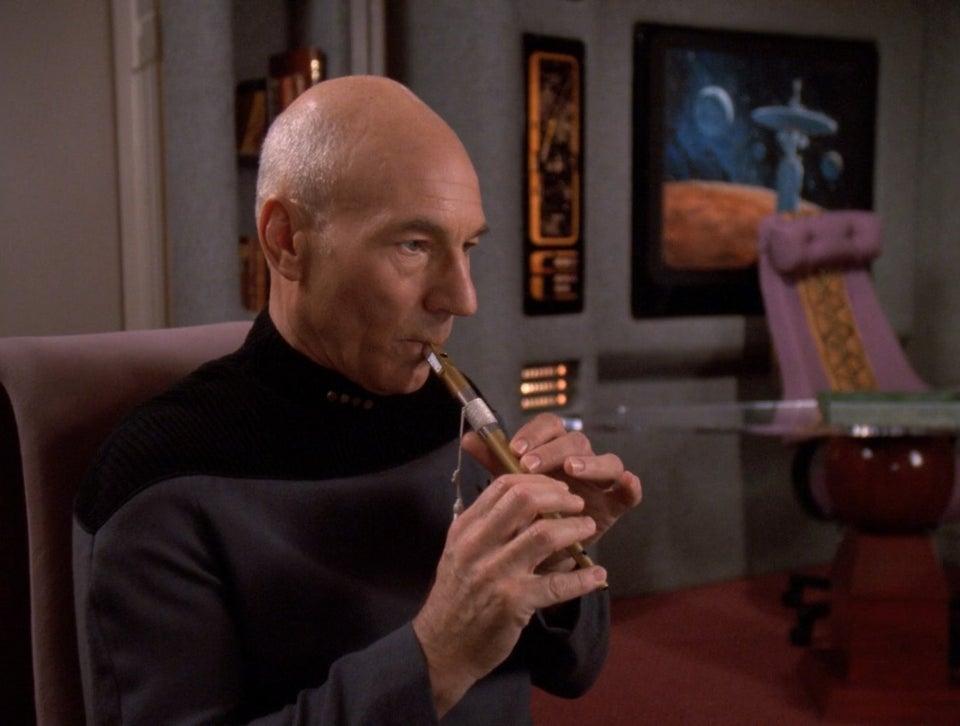
10. The Ressikan Flute (Almost)
In the theme song of the show, the opening and closing segments of the tune feature a high-pitched flute that, for hard-core fans, immediately brings to mind the Ressikan flute, an artifact from a bygone civilization that Picard inadvertently learned how to play when a neural probe cause him to personally relive a lifetime from the planet’s now-extinct culture. Jerry Russo, composer of the theme song, stated plainly in ‘The Ready Room’ (an informational talk-show-esque series that airs directly after episodes of ‘Picard’) that he intentionally featured a piccolo in the theme expressly for this connection. The Ressikan flute means so much to Jean-Luc that he routinely keeps it close to him among his prized possessions; the flute itself was last seen on his desk in his ready room on-board the Enterprise-E.

9. The Poker Game & Data’s “Winning” Hand
The episode opens on a swooping space-faring shot of the Enterprise-D in flight (the first time the ship has been seen on the small screen since appearing briefly in the series finale episode of ‘Star Trek: Enterprise’ back in 2005), eventually zooming in on the Ten Forward lounge wherein Picard and Data are playing poker. It’s a dream sequence, but one that ties directly to the series finale episode of ‘Star Trek: The Next Generation,’ entitled “All Good Things…,” where Picard joins his senior staff for a game of poker and laments that he “should have done this a long time ago.” Also of note here is the “winning” hand that Data shows upon Picard calling his all-in bet: five Queens. Is the bevy of “Qs” on the cards a portent of an appearance by long-time Picard alien antagonist Q? Are they a reference to the Borg Queen, since the Borg are clearly in play relative to the story line as seen at the conclusion of the episode? Only time will tell what (if anything) this five-of-a-kind is meant to allude to.
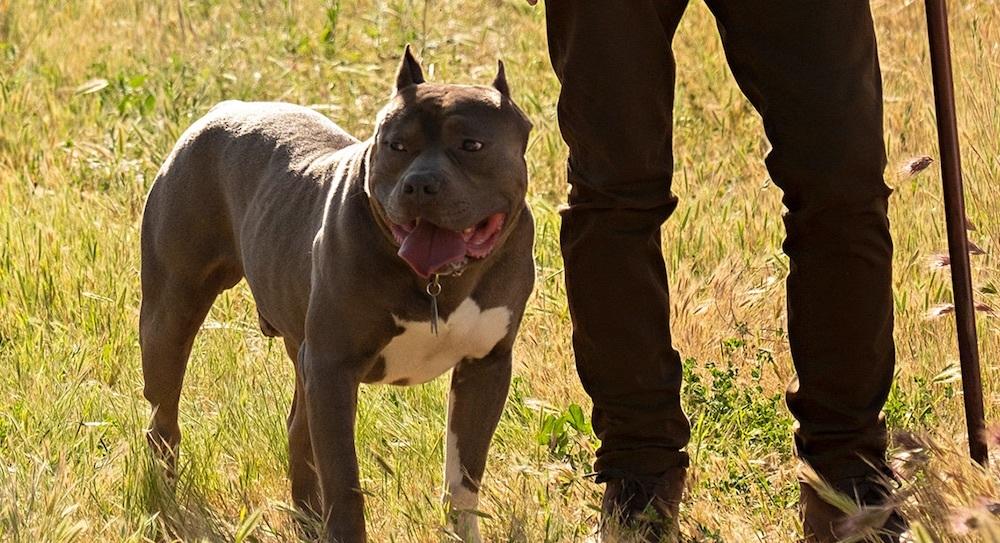
8. “Number One”
This one is plain as day, with perhaps a hint of emotional/mental subtlety to it: Jean-Luc names his dog “Number One,” the same nickname he bestowed upon Commander Riker throughout the course of their professional relationship. At first, it just seems like a fun little connection but there is likely a deeper subconscious meaning here: ever since Picard resigned from Starfleet, he really hasn’t been “in charge” of anything even remotely close to the amount of stature and responsibility that he had as a starship Captain (and eventually a fleet Admiral), so perhaps this is way of trying to “take charge” of whatever he can in his life. Showrunner Michael Chabon stated as such in an interview on ‘The Ready Room’ – when asked about the dog’s name, he said, “It’s an Easter egg, and it’s cute and it’s charming, but at the same time… there’s something poignant about it.”
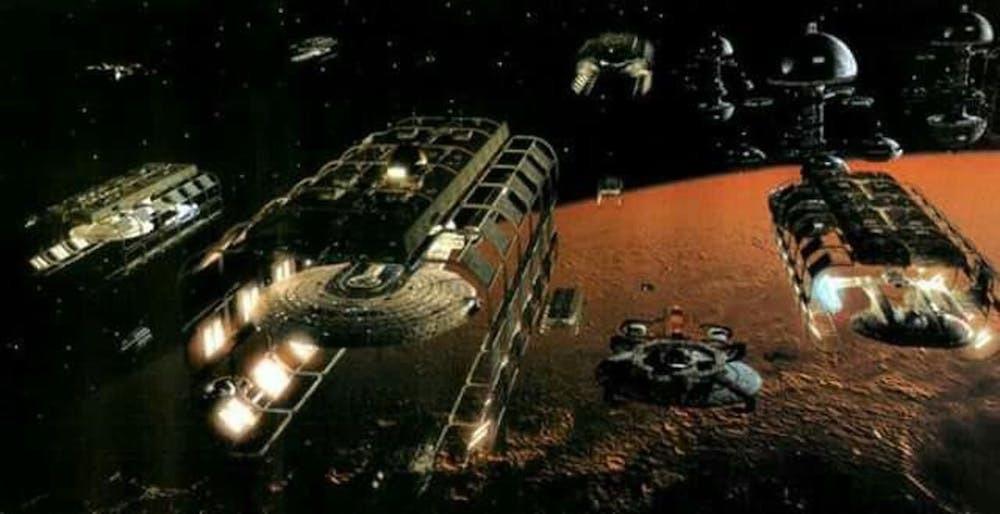
7. Utopia Planitia Shipyards
Often mentioned in passing throughout many of the Star Trek TV series, Utopia Planitia is a large-scale starship factory located both on the surface of Mars and above in orbit. Many Trek-famous starships were constructed there, including the Enterprise-C, Enterprise-D, Defiant, and Voyager. The destruction of the Shipyards carries the most direct plot connection to the rebooted Star Trek films, as the construction site was noted to be working on a wide array of vessels that were to be part of the rescue effort of Romulus after it’s star went nova, as first outlined in the 2009 ‘Star Trek’ film.
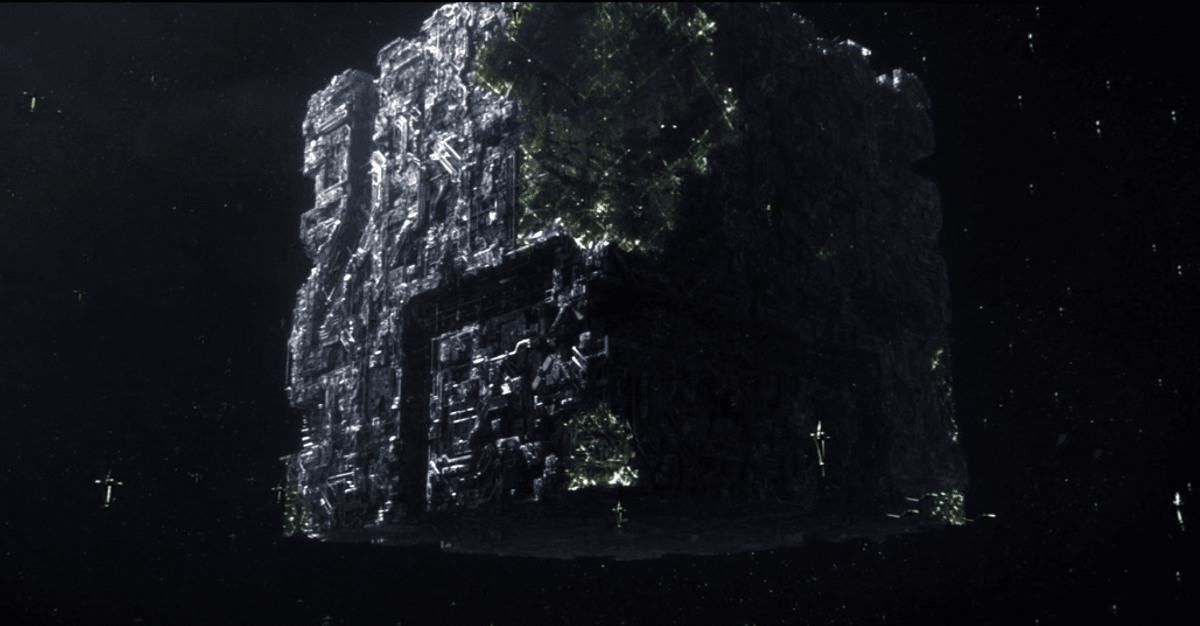
6. Narek & the Romulan Reclamation Site
Aside from the episode-ending bombshell that the site of the Romulan rebuilding efforts are taking place inside the apparent wreckage of a Borg cube (something that surely doesn’t bode well for former Borg drone Locutus aka Jean-Luc Pacard), we are introduced in the final scene to Narek, a Romulan that is apparently at the forefront of the Romulan Reclamation work. Narek mentions that he lost his brother about a year prior; this is pure speculation on our part at this point, but could Narek’s brother be Nero, the fanatical Romulan mining ship captain that traveled back in time and whose actions cause the “Kelvin Timeline” of the JJ Abrams films to come into existence? At the time of “Remembrance,” the Romulan supernova happened 10 years ago, and it was never expressly stated how long after the supernova that Nero and his crew of his ship, the Narada, traveled back in time, so the timing could theoretically work. Plus, the Narada was such a powerful ship because it was retro-fitted with Borg technology (according to the canon-ish ‘Star Trek’ prequel comic book miniseries ‘Star Trek: Countdown’), which could be another connection to what viewers were shown at the end of “Remembrance.” An intriguing theory, to be sure!

5. Data’s Paintings
Throughout ‘Star Trek: The Next Generation,’ one of Data’s biggest driving forces was his desire to become “more human.” To this end, Picard and the Enterprise crew often encouraged him to try his hand at various fine arts, in an attempt to understand the more emotional side of these activities. Data seemed to find particular interest in painting, and creates several works of art throughout the course of the series. Although the two paintings we see him create in ‘Picard’ are not directly shown in ‘The Next Generation,’ in the latter show he also expressed a desire to have a daughter, even going so far as to build a model, Lal, who would eventually have to be shut down due to a neural net failure. Lal’s physical appearance was no so different from Dahj’s…

4. A Plethora in the Starfleet Quantum Archives
When Jean-Luc visits his personal room in the Starfleet Quantum Archives, the entire space is essentially one callback after another, as a remembrance to Picard’s illustrious career. Among the items that can plainly be seen: models of the starships Enterprise-E, Enterprise-D, Stargazer (Picard’s first command), and Cousteau (the detachable “Captain’s Yacht” as seen in ‘Star Trek: Insurrection’); Klingon bladed weapons, including a bat’leth and ceremonial dagger (remember, Picard has a long history of working with the warrior race, including briefly serving as the Arbiter of Succession); the “Captain Picard Day” banner (albeit much less shiny) from ‘The Next Generation’ episode “The Pegasus”; and a few awards that may have happened in as-yet untold Picard stories, such as crystal plaques that say “Children of Jama” and another that reads “Betazoid Loyalties” (also featured on display on the 2019 San Diego Comic Con in the “Picard Exhibit”).
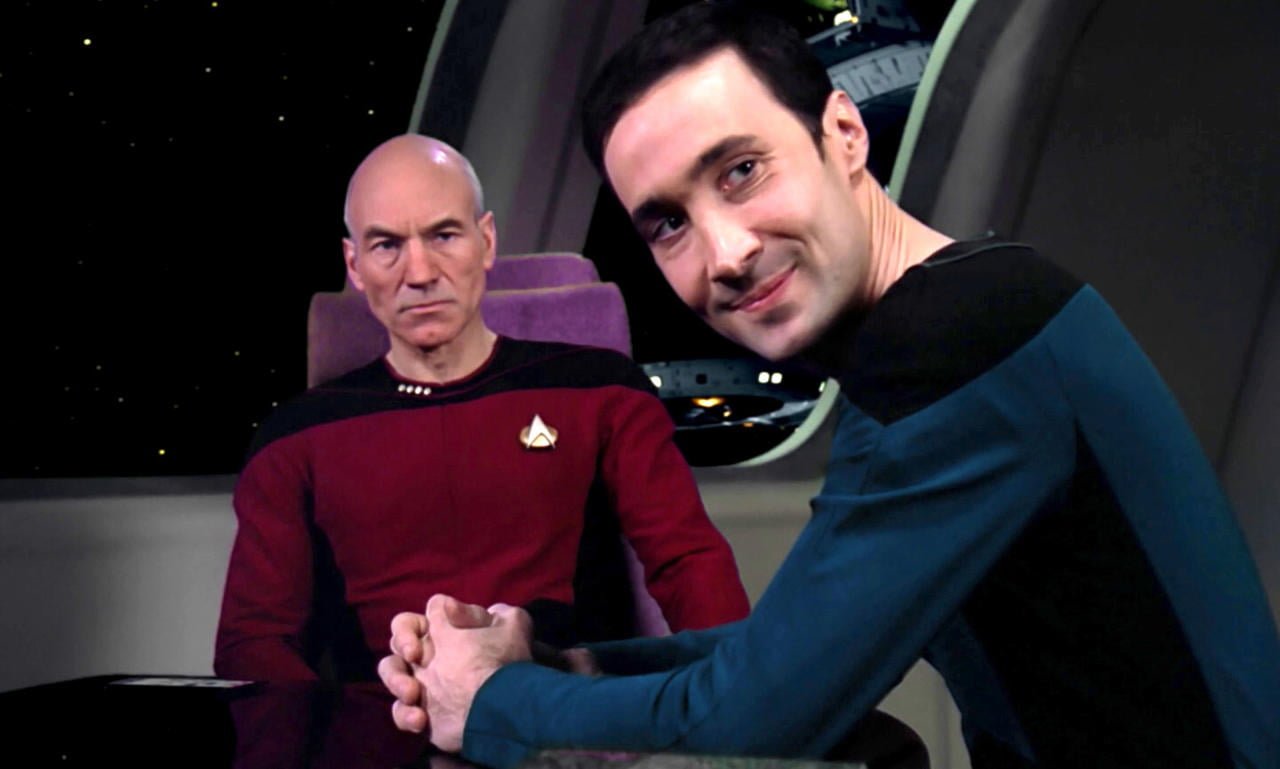
3. The Daystrom Institute & Dr. Bruce Maddox
This Trek reference has origins that throwback all the way to the Classic Star Trek series back in the 1960s, as the Daystrom Institute was named after Richard Daystrom, one of the foremost “modern geniuses” of robotics, who first appeared in the 1968 episode “The Ultimate Computer.” Several Trek shows that followed, including heavily in ‘The Next Generation,’ established the Daystrom Institute as a highly-respected and wide-ranging Federation research center with several locations across the galaxy. When Picard visits the Okinawa, Japan location and talks with Dr. Jurati in “Remembrance,” he learns of the disappearance of Dr. Bruce Maddox, a prominent cyberneticist who formerly worked for Starfleet and was an integral part of the Data-centric plot of the episode “The Measure of a Man.”

2. The Federation News Network (FNN)
As indicated by the logo being prominently displayed during Picard’s interview, the Federation News Network (FNN) is alive and well in the late 24th Century, even if we haven’t seen much of them on-screen throughout much of Star Trek’s history. The news content was also featured in the ‘Picard’ adjacent ‘Short Treks’ episode “Children of Mars,” but you may be surprised to learn (or surprised to remember, for Trek fans who have forgotten) that the FNN was established on-screen more than 25 years ago, back in ‘Star Trek: Generations’ in 1994, when a gaggle of FNN reporters covered the ill-fated maiden voyage of the Enterprise-B under Captain John Harriman with the “living legend” of Captain James T. Kirk ceremonially aboard as well.

1. The Dixon Hill Fedora
There were several “deep cuts” in the episode that only die-hard fans would stand a chance of catching (Dahj’s boyfriend being Xaheyan and the Trill member of the Picard interview team being prime examples), but this one may be the deepest cut of them all. In a blink-and-you’ll-miss-it moment as Picard prepares for his interview and looks himself in the mirror, a tan fedora with a black band is hanging from a nearby coat rack; clearly more than just a random fashion choice, this is the preferred headwear of Dixon Hill, a fictitious private investigator that has been a hero of Picard’s since his childhood, as heavily referenced throughout the run of ‘Star Trek: The Next Generation’ and into the TNG films (specifically in a very memorable holodeck scene in ‘Star Trek: First Contact’).
Did you catch any deep-seated Easter eggs in “Remembrance” that we didn’t mention? Sound off in the comments below and let us know!
